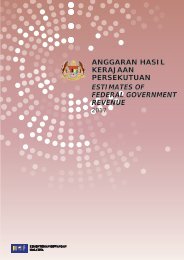WEALTH
2c0esX1
2c0esX1
Create successful ePaper yourself
Turn your PDF publications into a flip-book with our unique Google optimized e-Paper software.
MACRO<br />
to 2007 encouraged a belief in stability that lulled<br />
complacent policymakers and regulators into ignoring the<br />
dangers of dubious practices that set up a fragile and<br />
unstable financial system.<br />
“The other thing worth observing,” Eichengreen says,<br />
“is that it is also remarkable that we weren’t more aware of<br />
those parallels and their implications – that it could all end<br />
horribly – while they were unfolding.”<br />
What went wrong? “I think the big mistakes, the major<br />
examples of wrong lessons, were the decisions made before<br />
the recent crisis.” These included the failure to strengthen<br />
financial regulation and deal with the derivatives problem;<br />
the dismantling of Glass-Steagall in the United States; and<br />
the enthusiasm for light-touch regulation.<br />
HISTORY SURE CAN RHYME<br />
Yet if mistakes were made before 2008, decisions made that<br />
year show that if history does not repeat, it sure can rhyme.<br />
While the Fed rescued the investment bank Bear Stearns,<br />
much as the interwar Fed had done for the Central Republic<br />
of Chicago, it balked at bailing out Lehman Brothers, just as<br />
in 1933 it chose to make a statement by letting Henry Ford’s<br />
Union Guardian Trust of Michigan go under.<br />
“One might think that this history would have informed<br />
decision-making,” Eichengreen writes. “In the heat of the<br />
moment, it did not.” In the case of Guardian Trust, that<br />
created long lines of depositors clamoring outside banks<br />
across the United States, and sent the financial system into<br />
free fall.<br />
“Recent decision-makers were blindsided by history,”<br />
he told PROJECT M. “History informed their decisions<br />
of how to respond but it also blinded them to risks that<br />
had no parallel.”<br />
Eichengreen argues that the single most influential<br />
analysis of the Depression was A Monetary History of the<br />
United States, 1867–1960, written in 1963 by Nobel Prizewinning<br />
economist Milton Friedman and Anna J. Schwartz.<br />
Their 110-page chapter on the 1930s focused on the collapse<br />
of the banking system that made the Depression “Great.”<br />
For Eichengreen, policymakers interpreted Friedman<br />
too literally. The problem of retail bank runs had been<br />
solved, thanks to the 1930s innovation of deposit insurance,<br />
so the panicked bank runs of the Great Depression could be<br />
avoided. But by focusing on monetary supply and banking,<br />
modern policymakers missed the dangers lurking in the<br />
shadow banking system (hedge funds, money market<br />
mutual funds and commercial paper issuers) until too late.<br />
“There was no significant shadow banking in the<br />
1930s, so Friedman and Schwartz didn’t emphasize it,” he<br />
explains. When Lehman failed, money market funds<br />
holding short-term notes suffered runs by frightened<br />
shareholders. Large investors then made runs on the<br />
money funds’ investment bank parents, leading to the<br />
collapse of the securitization market. This caught<br />
policymakers and central bankers totally off guard.<br />
When the markets imploded, unlike in the 1930s,<br />
governments realized they were on the brink of depression,<br />
so they quickly intervened. They ramped up massive<br />
programs of fiscal spending, and central banks flooded<br />
markets with liquidity until a semblance of economic<br />
normality returned. A catastrophic worldwide depression<br />
was avoided, but is collegial backslapping justified?<br />
Eichengreen doesn’t believe so, arguing that the<br />
interventions were far less effective than they could have<br />
been. Post-crisis recovery in the US has been disappointing<br />
by any measure, while Europe experienced double-dip<br />
recession and a series of renewed crises starting in 2010.<br />
But because the recent crisis was less severe than the<br />
Depression, at least in the US, bankers have also been able<br />
to resist making radical reforms, leaving the world<br />
vulnerable to new financial shocks. “Success,” he concludes,<br />
“was also the mother of failure.”<br />
What is needed, as Eichengreen summarized to<br />
PROJECT M, is to require banks, especially big ones, to hold<br />
significantly more capital. He also argues that the conflict<br />
of interest of credit rating agencies – acting as advisor on<br />
how to obtain Triple A ratings and also conferring them –<br />
has to be resolved.<br />
Shadow banking remains a threat. Risks have been<br />
moved into clearinghouses, but concentrated rather than<br />
eliminated. “Moving derivatives onto electronic exchanges<br />
where they can clear as soon as they are done is what<br />
is needed,” he states. “And if some derivatives are too<br />
complicated, too complex, too exotic, too thinly created to<br />
be moved onto exchanges, then it is a good argument for<br />
regulating them out of existence.”<br />
So, what of the future? Eichengreen eschews the notion<br />
of “lesson” when it comes to history, but if the past holds a<br />
parallel relevant for the Fed today, it comes not from the<br />
1930s, but from 1929. That year, concerned about excess on<br />
Wall Street, the Fed raised interest rates to deflate the<br />
bubble. It succeeded beyond expectations, setting up<br />
conditions for the Great Depression.<br />
“If you are concerned about deleveraging, imbalances<br />
and excessive risk taking in the financial sector, there<br />
are instruments better suited for addressing those<br />
risks,” he says. “That is regulation, what is called macroprudential<br />
policies, where regulators clamp down on<br />
margin purchases of securities on risky lending.<br />
Raising interest rates increases the danger that the<br />
economy will tank. It is what the Fed did in 1929 and what<br />
the Fed should avoid today.”<br />
56 • Allianz



